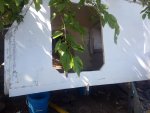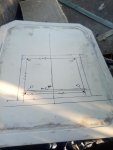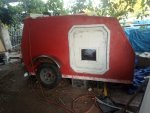What makes this cheapest you do your own skin you start with a bucket of resin and fiberglass material and anything flat.
The foam averages $ 22 US for a 1-inch piece. when you make your own skin you can add woven which makes them extremely strong.
YOU drill angle holes all the way through the foam locking it from any movement.
If you let the resin drizzle through it will try both skins together so the foam density means nothing . you don't have to fill the holes with resin just let it drizzle where hole gets a real small lining tying the Skins together. you have all these little tubes of resin in the foam on a 4 to 6 in grid.
t
The video just give you an idea of the process but you are making your own skin you don't have to use high density foam. Jess is great at making videos to me is so easy ten words would explain it.
By making an interior and exterior Bond beam fiberglass you're not paying that high price for aluminum, corners and you have made a fiberglass skeleton. everything .
pretty much expands the same.
the strength from the structural panel is the distance between the two skins.
You will be making your own skins mat is the bulk and the woven makes it extremely strong. .if you want to use a different type of foam then you can make your own skin because the store-bought ones are all polyester .then bond with epoxy . Also the door jamb will be adding quite a bit of strength
you are the factory for the skin and it has insulation where plywood would not
This way of building when the first start seems extremely flimsy but its strength is in the sum of all its parts.
you are making your own skin the density of the foam does not mean anything.
By making your own panels This Way you put an actual bowl shaped into the panel . so everything is under load it makes it extremely strong.
as that interior Bond beam pulled in just a little bit and when you revit and glue it together it is actually pulling the roof down onto the walls
with building anything you have to use your due diligence always great to read about perspectives from different parts of the world
you don't use epoxy The foam is cheap big box store insulation foam isocyanate. one of the businesses I am involved they use quite a bit of foam but it's $400 a sheet.
I figured out here in the US by buying off-the-shelf not wholesale . with increased cost. 4,5 by 9 foot 1 in foam about $120 a panel . you have insulation something that won't rot can take an impact light make with under 100 bucks in tools . it would be nice if you wax it once or twice a year and maybe every five to 10 years spray clear coat over it. if you have any damage you go to Walmart.
Has Prudential the last hundreds of years with little maintenance. Wood not so much. you could put a hole in it the size of a basketball and a few years you might have to think about fixing it cuz there's nothing to rot.
A s with any project you have to figure out the pros and cons. upfront cost yearly maintenance, cost of Towing. a big one storage if you have to pay the storage that's time
12.
All I can go by is cost here in the US.
From the repair shops that I am invested in and from trade manuals they say about from 55% to 70% of all manufactured RVs are going to need major repair within the next 10 years.
So it's no surprise that labor rates are high—they average between $150 and $170 an hour nationally. A price like that makes even simple, commonplace repairs expensive. Many RV repairs occur at dealerships, which may be even more expensive.. Most go by book rate Which is higher than the actual hour you work.
Even the most uncoordinated never built a thing would Excel.
$11 piece of hardboard works great for a flat surface
















